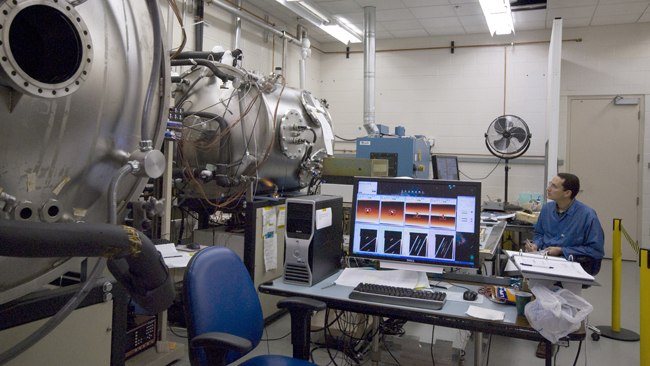Space: Exploring the final frontier
Utah State University’s Space Dynamics Lab (SDL) is a huge research facility, consisting of six buildings and 200,000 square feet of laboratory, office and conference space. The headquarters are located in North Logan, with other SDL offices located in Massachusetts, New Mexico and Colorado.
Karen Wolfe, SDL public communications manager, said the SDL designs, develops, manufactures and tests remote sensors for science, environmental and military applications. The SDL works on several NASA programs.
Because the SDL headquarters are so large, the lab can create the numerous out-of-this-world projects currently underway there.
Right now, the SDL is building a high-tech telescope that will identify the earliest stars and survey the entire sky to create the star catalog for the James Webb Space Telescope, Wolfe said. This infrared map will be 1,000 times more detailed than maps from prior sky surveys.
The telescope is part of the Wide-field Infrared Survey Explorer (WISE) project. WISE is “NASA’s only mid-class explorer mission right now,” Wolfe said.
Once launched, the WISE telescope will take pictures of the sky every 11 seconds and is projected to be in outer space for about six months documenting stars in infrared view not normally visible.
According to their brochures and informational CD, in addition to creating the WISE telescope, the SDL also runs extensive environmental tests and calibration exercises. One such test is the “vibe test” in which instruments are bolted to a table, vigorously shaken, and observed to ensure stability. Look for the launch of WISE about a year from now.
While the WISE project is a “hot” topic at the SDL right now, as many of the SDL engineers say, there are many other experiments that contribute to the SDL’s reputation as a leader in electro-optical sensor systems. Last year, the SDL sent an instrument into space that is currently helping scientists gather data and better understand global climate changes.
Wolfe said SOFIE, as this project is called, was launched in 2007 and makes measurements of high-altitude clouds normally seen only in polar regions about 55 miles above Earth. The data will help scientists understand why these clouds have been moving to much lower latitudes in recent years.
In addition to the world-renowned scientists and engineers that design and build projects at SDL, several students have also had the opportunity to help in the creation process. Wolfe said one type of student project at the SDL is the cube satellite that is relatively inexpensive compared to larger satellites. Cube satellites are about the size of a tissue box.
One of the advantages of “cubesats,” as Wolfe called them, is that they are small and inexpensive enough that a large number of them could be placed around the entire globe, gathering real-time information that can be compared to other cubesats; something the larger satellites cannot do. Many student projects have also recently landed on the International Space Station.
The SDL has about 400 employees and about one quarter of the work force consists of USU students. At any given time, students from various disciples work at the SDL, not just engineering majors.
Kami Huntsman, senior majoring in accounting, has worked for the SDL for more than a year and said she really enjoys her job as an accounts payable clerk.
“My job includes entering vendor invoices on purchase orders and processing checks to pay those vendors. I also help track and account for SDL’s travel to ensure all parts of every trip are charged correctly,” Huntsman said.
Huntsman works in an environment with six accountants and two other students majoring in accounting. Huntsman said she gets to apply the basic accounting principles she learns in class and the SDL is serving as a stepping-stone for her future.
“Interviewers are always curious about what we build (at the SDL) and how much things cost,” she said.
Wolfe said the SDL allows students to have “hands-on, real world experience that gives them the opportunity to hit the ground running once they graduate.”
Despite the fact that the SDL is a nonprofit research and development corporation owned by USU, the lab generates all of its own revenue, which means the SDL “receives no line item funding from either Utah State University or the state of Utah,” said Wolfe.
It is a very competitive process, however the Space Dynamics Lab has been recognized and receives contracts from government agencies such as NASA and the Department of Defense. According to a brochure from the SDL, the revenue that comes from NASA alone accounts for about half of the $55 million the SDL brought into Cache Valley last year.
From start to finish, the WISE project is predicted to generate over $70 million dollars for the SDL, Wolfe said.
No doubt, the SDL represents Utah State well in the realm of innovative solutions for science and technology and once the WISE project is completed, another “hot” topic will emerge and the SDL will continue various projects. For more information about any of the SDL’s programs visit spacedynamics.org.
–courtney.schoen@aggiemail.usu.edu

